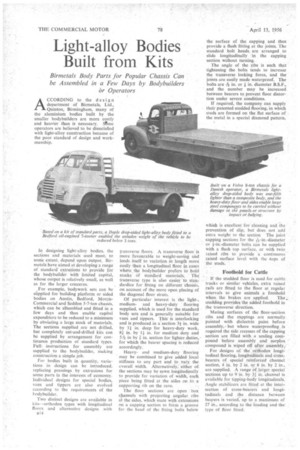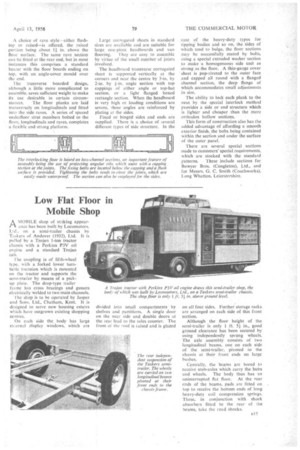Light-alloy Bodies Built from Kits
Page 48

Page 49

If you've noticed an error in this article please click here to report it so we can fix it.
Birmetals Body Parts for Popular Chassis Can be Assembled in a Few Days by Bodybuilders or Operators
ACCORDING to the design department of Birmetals, Ltd., Quinton, Birmingham, many of the aluminium bodies built by the smaller bodybuilders are more costly and heavier than is necessary. Ante operators are believed to be dissatisfied with light-alloy construction because of the poor standard of design and workmanship.
In designing light-alloy bodies, the sections and materials used must, to some extent, depend upon output. Birmetals have aimed at developing a range of standard extrusions to provide for the bodybuilder with limited capital, whose output is relatively small, as well as for the larger concet ns.
For example, bodywork sets can be supplied for building platform or sided bodies on Austin, Bedford, MorrisCommercial and Seddon 5-7-ton chassis, which can be Ambled and fitted in a few days and thus enable capital expenditure to be reduced to a minimum by obviating a large stock of materials. The sections supplied are not drilled, but completely cut-and-drilled kits can be supplied by arrangement for continuous production of standard types. Fullinstructions for assembly are supplied to the bodybuilder, making construction a simple job.
For bodies built in quantity, variations in design can be introduced, replacing pressings by extrusions for some parts in the interests of economy. Individual designs for special bodies, vans and tippers are also evolved according to the requirements of the bodybuilder.
Two distinct designs are available in kits—orthodox types with longitudinal floors and alternative designs with B14 transverse floors. A transverse floor is more favourable to weight-saving and lends itself to variation in length more easily than a longitudinal floor in cases where the bodybuilder prefers to hold stocks of standard materials. The transverse type is also easier to stan-' dardize for fitting on different chassis, on account of the more open placing of the diagonal floor struts.
Of particular interest is the light-, mediumand heavy-duty flooring supplied, which is used for the standard body sets and is generally suitable for vans and tippers. This is interlocking and is produced in a' section 34 in. wide by 11 in. deep for heavy-duty work, 81 in. by 11 in for medium duty and 5T5g in by in. section for lighter duties,: for which the bearer spacing is reduced accordingly.
Heavyand medium-duty flooring may be combined to give added local stiffness to any part and to vary the overall width. Alternatively, either of. the sections may be sawn longitudinally to provide for variation of width, each piece being fitted at the sides on to a supporting rib on the rave.
The floor sections are open box channels with projecting angular ribs at the sides, which mate with• extensions on a capping section to form a groove for the head of the fixing bolts below the surface of the capping and thus provide a flush fitting at the joints. The standard bolt heads are arranged to slide longitudinally in the capping section without turning.
The angle of the ribs is such that tightening the bolts tends to increase the transverse locking force, and the joints are easily made waterproof. The bolts are 15G in. or 1 in. diameter B.S.F., and the number may be increased between bearers to prevent floor distortion under severe conditions.
If required, the company can supply their patented studded flooring, in which studs are formed on the flat surface of the metal in a special diamond pattern,
whieb is excellent for cleaning and the prevention of slip, but does not add extra weight to the section The joint capping sections for the-in.-diameter or 1-in.-diameter bolts can be supplied with a flush top surface, or with twin raised ribs to provide a continuous raised -surface level with the -tops of the studs.
• Foothold for Cattle
If the studded floor is used for cattle trucks or similar vehicles, extra raised rails are fitted to the floor at regular intervals to give animals a foothold when the brakes are applied. The. studding provides the added foothold in the transverse direction.
Mating surfaces of the floor-section ribs and the cappings are normally painted with dielectric paint before assembly, but where waterproofing is required the side recesses of the capping section are filled with a sealing compound before assembly and surplus compound is wiped off after assembly.,
For designs of the .orthodox longitudinal flooring, longitudinals and Cross bearers of special reinforced channel section, 4 in. by 2 in, or 6 in. by 2 in., are supplied. A range of larger special sections up to 9 in. by 31 in. channel is available for tipping-body longitudinals. Angle stabilizers are fitted at the intersection of cross-bearers and longitudinals and the distance between bearers is varied, up to a maximum of 27 in., according to the loading and the type of floor fitted.
A choice of rave style—either flushtop or raised—is offered, the raised portion being about 11 in. above the floor surface. The same rave 'section can be fitted at the rear end, but in most instances this comprises a standard bearer with the floor boards ending on lop, with an angle-cover mould over the end.
The transverse boarded design, although a little more complicated to assemble, saves sufficient weight to make its use desirable in certain circum stances. The floor planks are laid transversely on longitudinals and fitted into the side raves. A series of spaced underfloor strut menffiers bolted to the floor, longitudinals and raves, completes a flexible and strong platform. Large corrugated sheets in standard sizes are available and are suitable for large one-piece headboards and Van flooring. They are easy to assemble by virtue of Use small number of joints involved.
The headboard transverse corrugated sheet is supported vertically at the corners and near the centre by 3-in. by 2-in. by +-in. angle section with top cappings of either angle or top-bat section, or a light flanged boxed rectangle section. When the headboard is very high or. loading conditions are severe, these angles are reinforced by plating at the sides.
Fixed or hinged sides and ends are supplied. There is a choice of. several different types of side structure. In the
case of the heavy-duty types for tipping' bodies and so on, the sides of which tend to bulge, the floor sections nay be successfully mated by bolts, using a special extruded washer section to make a homogeneous side unit as strong as the floor. A thin-gauge cover sheet is pop-riveted to the outer face and capped all round with a flanged channel section, the deep flange of which accommodates small adjustments in size.
The ability to lock each plank to the next by the special interlock method provides a side or end structure which is lighter and cheaper than the more .orthodox hollow sections.
This form of construction also has the added advantage of affording a smooth exterior finish, the bolts being contained within the section and under the surface of the outer panel.
There are several special sections made to customers' special requirements, which are stocked with the standard
patterns. These include sections for Bowyer Bros. (Congleton), Ltd., and for Messrs. G. C. Smith (Coachworks), Long Whatton, Leicestershire.




















































































































